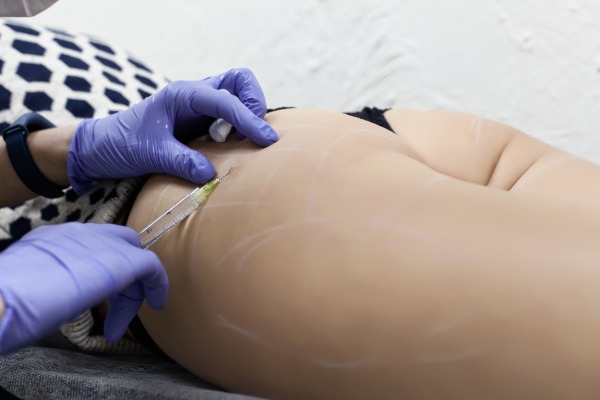
Procedure Time: 30-45 minutes
Recovery Time: 24 hours, no exercise for 1 week
Results Duration: 12-18 months
Cost: Dependent on brand and product type
Anaesthesia: Local anaesthesia
For a full list of FAQs please Click Here.
Injectable Body Contouring is used for the enlargement and enhancement of the breasts, calves and buttocks and also for evening out discrepancies in skin surface such as those sometimes caused by liposuction. The first body shaping and volume restoration product which uses hyaluronic acid to achieve this is called Macrolane™ VRF which is no longer indicated for breasts. Treatment involves a small incision in the area and the injection of the substance using a thin cannula or large gauge needle. Due to the fact that the body will metabolise the hyaluronic acid over time, yearly top-ups are required to maintain the optimal results, which should last 12 - 18 months. The quantity required at top-ups may reduce over time. Private costs for injectable body contouring treatment depends on the type and size of the area(s) being treated, such as breast or buttock reshaping and the amount of product required. Typically an initial breast injection treatment will cost in the region of £2,500 - £3,000, with top-up treatment in a year's time in the region of £1,400.
Do you have a question? Ask one of our experts NOWHistorically, men and women around the globe have submitted to the introduction of all sorts of substances, some more desirable than others, into their bodies in order to achieve an augmentation of areas such as the breasts and buttocks, or to even out discrepancies in the skin’s surface caused by trauma or disease. From early attempts with paraffin and non-medical grade silicone to harvested autologous fat and permanent dermal filler products, the science of adding volume to the body has thankfully come along way.
2008 saw the launch of a new product on the UK market called Macrolane™ VRF which has become the first body shaping and volume restoration product which uses hyaluronic acid, a natural component of our own bodies.
It is currently indicated for shaping of the breasts, calves and buttocks and also for evening out discrepancies in skin surface such as those sometimes caused by liposuction.
Update (April 2012)
Q-Med has decided to discontinue the breast indication for Macrolane until consensus for best practices in breast radiology examination following Macrolane treatment has been reached. For more information on this, please read our Blog.
If you are considering Injectable Body Contouring the following information will give you a basic understanding of the procedure. It can't answer all your questions, since a lot depends on the individual patient and the practitioner. Please ask a practitioner about anything you don't understand.
The actual procedure is generally well tolerated, due to the local anaesthesia. You may feel a tugging sensation during treatment as the cannula and substance moves around but you should not feel pain.
People may experience mild swelling, bruising or tenderness, which will be uncomfortable for the first first days post treatment but should resolve in approximately a week.
Scars from the points through which the substance is injected are very small and will often fade over a period of months - becoming barely noticeable.
Ideally treatment for breast reshaping should be carried out by a qualified cosmetic or plastic surgeon who has experience of traditional breast augmentation procedures and the anatomy involved, as well as having had bespoke training with the product.
Currently UK practitioners, both surgeons and cosmetic doctors, have been trained and certified in the use of products like Macrolane for body contouring, with approximately half of those also trained and certified for breast reshaping.
Be sure to verify the training credentials of any practitioner offering such treatments.
For more information about practitioner training, qualifications and relevant medical organisations please view the information contained within the Legislation section of the Consulting Room.